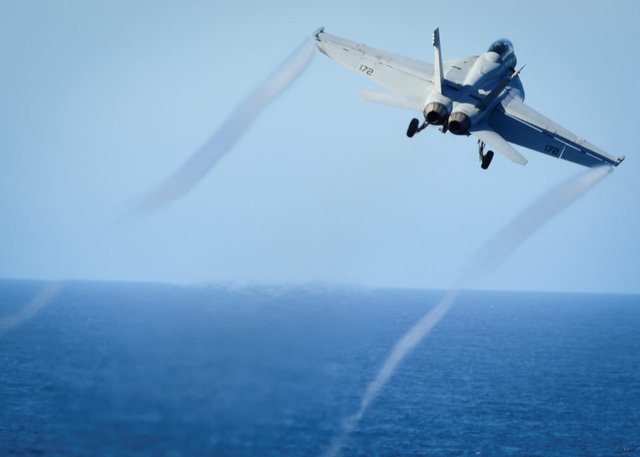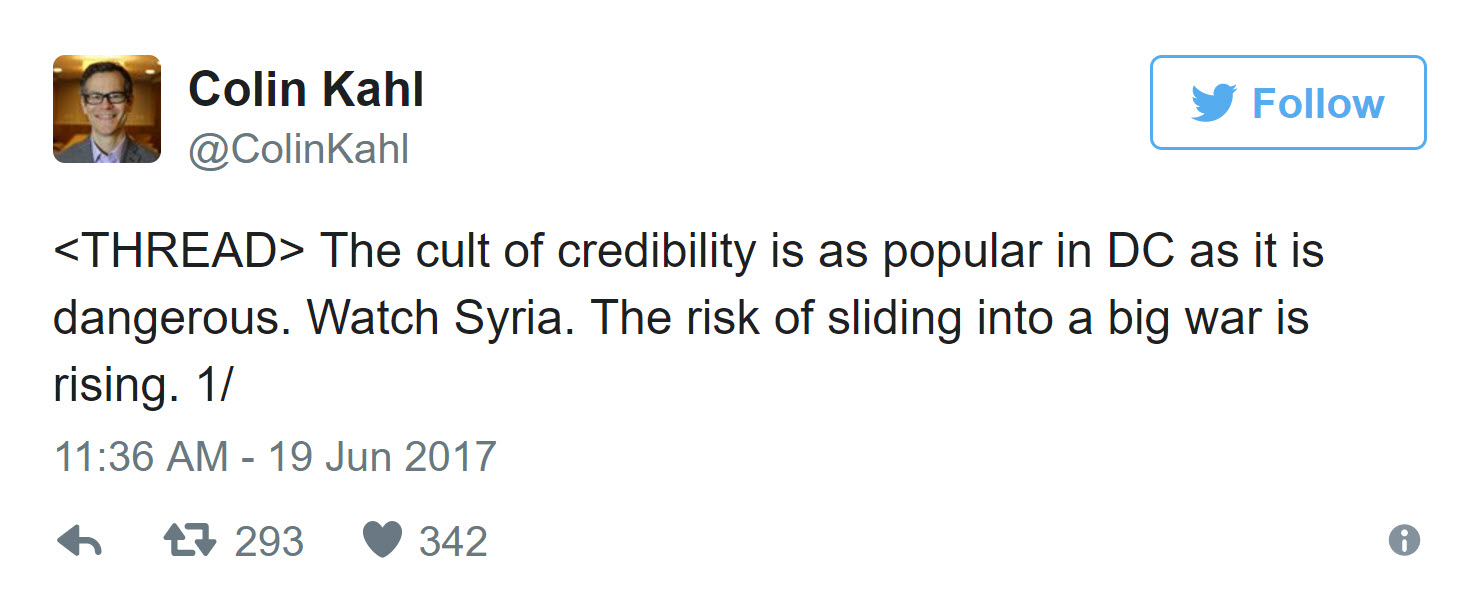
Russia’s defense ministry didn’t mince words Monday about its willingness to attack U.S. military jets in Syria.
Less than 24 hours after the U.S. shot down a Syrian air force jet, Russia threatened to target any U.S. jets flying west of the Euphrates River and announced it was cutting the “deconfliction line,” a direct means of communication set up between the two powers as a way to prevent any disastrous direct conflict in Syria.
Moscow’s heated response capped off a weekend of chaos, where the unprecedented downing of the Syrian warplane — the Pentagon said it had dropped bombs near forces allied with the U.S. — was made even more complicated by Iran, which over the weekend targeted ISIS by launching its first missile strikes into Syria. Analysts interviewed by VICE News warned that both the shootdown and the missile strikes signalled a new phase in the six-year war, one in which posturing and power plays by the U.S., Iran, and Russia will only increase as ISIS loses its hold on territory.
“There seems to be a race to [Syrian cities] Raqqa and Deir Ezzor on the part of the opposing actors in the conflict,” said Lina Khatib, head of the Middle East and North Africa program at the Chatham House think tank. “Everyone is using the liberation of the eastern region of the country from ISIS as an opportunity to flex their muscles vis-à-vis one another.”
Colin Kahl, former national security advisor to Vice President Joe Biden, warned Monday in a long series of tweets that recent events were threatening to sink the U.S. into a potentially disastrous Syrian quagmire.

Khatib echoed Kahl, adding that the competition between Iran and the U.S. risked fueling sectarian violence that could spill beyond Syria’s borders, making the already dim prospects of a political solution to the fighting even dimmer.
“A U.S.-Iranian confrontation is likely to be a new phase in the conflict,” she said, “rather than the beginning of the end.”
Upping the risk of unintended clashes
The Iran missile strikes into Syria will “put U.S. and Gulf nation leaders and military commanders on edge,” said Bill Roggio, editor of the Long War Journal. “I suspect Iran is not finished flexing its muscles and will launch more missile strikes in the future.”
But, he added, Russia’s threat to cut its deconfliction line with the U.S was the more immediate concern, putting “every pilot operating over Syria in danger.”
“This means that the U.S. and Russia are no longer in communication to prevent the accidental targeting of each other’s aircraft.”
Khatib believes Russia’s threat was likely just tough talk, and it would continue to keep the communication channel open. “Practically speaking,” she said, “it’s not in their interest, as any direct engagement would be catastrophic.” Russia had suspended the hotline in April after the U.S. struck a Syrian air base in retaliation for a chemical attack blamed on Syrian President Basha al-Assad’s forces, but communication later resumed.
The shoot-down of the Syrian jet Sunday highlighted the increased tensions resulting from the U.S. partnership with the Syrian Democratic Forces (SDF), a controversial militia on which Washington is relying as its key partner on the ground in the fight against ISIS. U.S. support for the militia, which has a large number of Kurdish fighters, has led to tensions with NATO ally Turkey, which regards the Syrian Kurdish forces as terrorists. The Syrian military has also fought the SDF, although at times they have acted with a degree of cooperation on the battlefield when fighting jihadist groups.
U.S. Central Command said in a statement that a U.S. F/A-18 shot down the Syrian army jet south of Tabqa “in collective self-defense of coalition-partnered forces” after “pro-Syrian regime forces” had attacked SDF in the town of Ja’Din. The statement added that the coalition did “not seek to fight the Syrian regime, Russian or pro-regime forces” but wouldn’t hesitate to defend itself or its partners from any threat.
Roggio said that the exact circumstances leading up to the shoot-down remained unclear, but the strong response made it likely that U.S. special forces were with SDF fighters when the Syrian warplane attacked. He said the developments pointed to the increasingly murky path ahead for U.S. efforts in Syria as the campaign against ISIS progresses.
“As the Islamic State’s territory in Syria shrinks, the U.S. is increasingly being put in direct contact with Syria and its allies,” he said. “The U.S. must decide if it wants to continue to actively support its proxies in the Syria civil war. If it does, it will be in direct conflict with Russia, Iran, Syria, and hostile Shia militias.”
What the hell is Iran doing in Syria?
Iran’s preparedness to escalate its military involvement was vividly illustrated Sunday when Iran’s Islamic Revolutionary Guard Corps (IRGC) launched medium-range missile strikes on ISIS targets in Deir Ezzor, a city in eastern Syria where the terror group’s fighters have increasingly fled as Raqqa is pounded with airstrikes from the U.S.-led coalition.
The IRGC said on its official news website that it launched the strikes in retaliation for twin ISIS terror attacks in Tehran earlier this month, and that many “terrorists” were killed and their weapons destroyed in the strikes, which targeted a command center and suicide car bomb facility.
Roggio said that while Iran had been actively involved in the conflict in support of Assad’s forces — IRGC advisors and units fight alongside Syrian forces and militia proxies — the missile strikes were a substantial escalation. Khatib echoed Roggio, saying that the missile strikes were intended to project power as the U.S. and Iran compete in eastern Syria ahead of ISIS’s eventual defeat in the region.
She also predicted that as the competition for control of the region intensified, U.S.-directed strikes against Iranian targets in eastern Syria would grow more likely.
“I think we can expect U.S. strikes on Iranian targets inside Syria to happen later this summer,” she said. “Whether they will be led by American aircraft or allies remains to be seen.”
By Tim Hume on Jun 19, 2017
Hi! I am a robot. I just upvoted you! I found similar content that readers might be interested in:
https://news.vice.com/article/a-flexing-contest-in-syria-may-trap-the-us-in-endless-conflict
Downvoting a post can decrease pending rewards and make it less visible. Common reasons:
Submit
Disclaimer: I am just a bot trying to be helpful.
Downvoting a post can decrease pending rewards and make it less visible. Common reasons:
Submit
Do you write all of this yourself? Its awesome!
Downvoting a post can decrease pending rewards and make it less visible. Common reasons:
Submit
It seems no matter where there are precious resources for exploitation there is a conflict...why can't the US focus on its own issues at home, instead of meddling in affairs it does not understand. Oh I forgot...it sells most of its military might to that region, oh yes and needs lots of oil to feed its economy. When is the american public going to see it for what it is?? And before you kick off...think about it for a little while!!
Downvoting a post can decrease pending rewards and make it less visible. Common reasons:
Submit